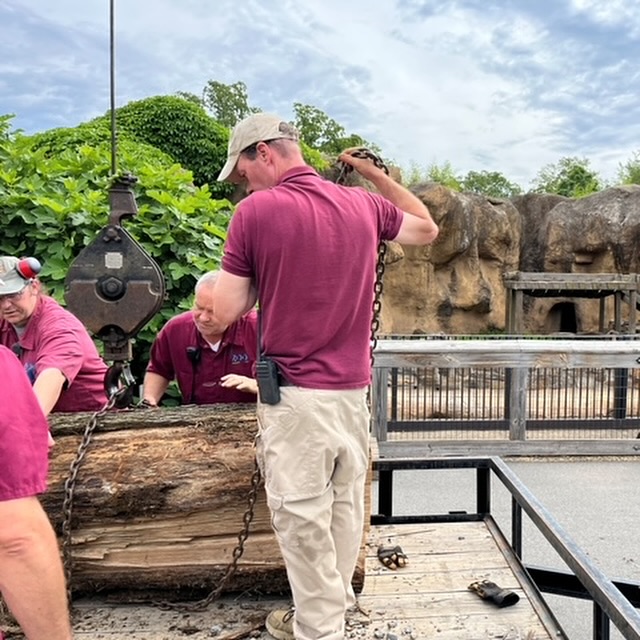- Renovations in zoo exhibits require careful planning, equipment, and teamwork.
- The importance of public safety and guest cooperation during zoo alterations.
- Benefits of the new environment for bear enrichment and welfare.
- Utilization of cranes and other equipment in zoo maintenance.
- The engaging nature of environmental changes for both animals and visitors.
Renovations in zoo exhibits are intricate, involving elaborate planning, diverse equipment, and collaboration among staff. On May 6th, the bear area of the zoo underwent a significant transformation that captivated both the bears and the visiting public. The old logs were removed, and new ones were installed, providing the bears with enhanced environmental enrichment. This article delves into the details of the project, highlighting the diligence of the zoo staff, the cooperation from guests, and the ultimate benefits for the bear inhabitants.
Zoo renovations involve a myriad of logistical tasks and safety measures. In the case of the bear exhibit, planning was crucial. Coordinating such an endeavor required seamless communication among bear keepers, maintenance staff, and outside contractors. Heavy equipment like cranes, forklifts, trailers, and trucks were essential for the installation of new logs, which serve as the bears’ new furniture. This collaborative effort ensured that the renovations were completed efficiently and safely.
The bear exhibit’s temporary closure was necessary for public safety. Grateful acknowledgment must be given to the guests who demonstrated patience and understanding. For a zoo, visitor cooperation is paramount when working on improvements that benefit both wildlife and patrons. Ensuring safety prevents accidents and allows staff to concentrate fully on the work at hand.
Animal welfare remains a top priority in modern zoos. The introduction of new logs and structures is more than just an aesthetic upgrade; it represents a commitment to animal enrichment. Enrichment involves creating stimulating environments that encourage natural behaviors. The new furniture allows bears to climb, lounge, and engage with their surroundings more dynamically. The assortment of logs provides varied textures and opportunities for physical activity, promoting mental and physical health.
Installing such enhancements is no simple feat. The logistical use of a crane to maneuver large logs is a critical operation. With precision and expertise, the staff ensured that the machinery was used safely and effectively. Moving the logs required strategic positioning and careful handling, highlighting the skill involved in maintaining such an engaging habitat.
Interestingly, the bears themselves seemed intrigued by the process. Observing logs flying through the air during the movement likely provided an unexpected source of enrichment. This engagement underscores the dynamic relationship between animals in captivity and their managed environments. Bears benefit from the diversification of their habitat, which in turns enriches visitor experiences as they observe these natural behaviors.
Overall, these renovations are an investment in the zoo’s commitment to conservation and education. By creating environments where animals can thrive, zoos play a crucial role in wildlife stewardship. The public, in witnessing these changes, gains insight into the dedication involved in animal care.
The educational aspect of such projects cannot be overstated. Visitors see firsthand the complexities of zoo operations and the transparency involved in ongoing improvements. This understanding can inspire future generations to become advocates for wildlife preservation, aligning with the zoo’s mission of fostering an appreciation for wildlife and a sustainable ecosystem.
This particular renovation project is a testament to the hard work and dedication of everyone involved. From the moment the decision was made to update the bear area, to the final placement of each log, it was a synergy of expertise, enthusiasm, and execution. The underlying lesson here is that even seemingly small changes make a significant difference in the lives of animals and the enrichment of human experience.
The expertise demonstrated by the zoo staff highlights the necessary balance between innovation and tradition. Traditional zoo exhibits are thoughtfully transformed with modern techniques, always prioritizing animal welfare and visitor education. Utilizing advanced equipment like cranes ensures that zoological parks continue to evolve as sanctuaries of learning and conservation.
Projects like this offer valuable opportunities for zoos to educate the public about the importance of wildlife preservation. As guests watch these developments, they become more aware of the essential care and commitment needed to maintain a thriving animal habitat.
In sum, the May 6th renovations at the zoo exemplify the complex yet rewarding nature of modern animal care. With conscientious planning and a focus on sustainability, zoos can offer excellent support for those who reside within. The bears’ new environment reflects thorough preparation, making zoo visits an opportunity for learning, engagement, and enjoyment.
*****
Source Description
Thanks to all the guests for their patience while the bear area was closed on May 6th for the bears to all get new furniture!
Removing all old logs and placing new ones on the exhibits requires renting a crane, using various other Zoo equipment such as trailers, trucks and forklifts. It was a team effort between bear keepers and maintenance staff working hard for several hours to get the job done. For public safety the area had to be closed to guests.
It was all worth it in the end as the bears are enjoying lounging on the new “furniture”, climbing on it and tearing the bark off. They even enjoyed watching the logs move across the air as they moved on and off exhibits with the crane!
📸Cred: Debbie T.

